Craigdarroch Castle
Craigdarroch Castle in Victoria, British Columbia, Canada, is a historic, Victorian-era Scottish Baronial mansion. It was designated a National Historic Site of Canada due to its landmark status in Victoria.[1]
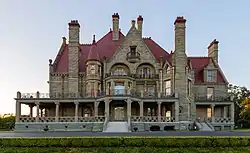 Viewed from the south | |
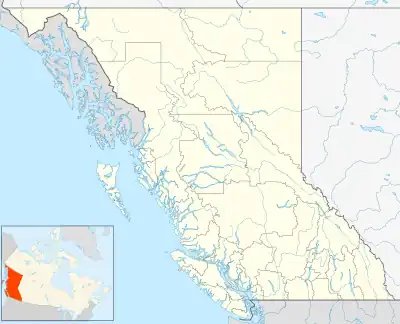 Location in British Columbia | |
| Established | 1890 (construction), 1979 (museum) |
|---|---|
| Location | 1050 Joan Crescent Victoria, British Columbia V8S 3L5 |
| Coordinates | 48°25′21.5″N 123°20′37.5″W |
| Type | Historic house museum (Victorian era/Victorian architecture) |
| Visitors | 150,000 per year |
| Public transit access | Victoria Regional Transit System #11 and #14 bus |
| Website | www.thecastle.ca |
| Official name | Craigdarroch National Historic Site of Canada |
| Designated | 1992 |
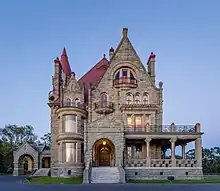
History
It was constructed in the late 19th century as a family residence for the wealthy coal baron Robert Dunsmuir and his wife Joan. Robert died in April 1889, 17 months before construction on the castle was completed. His sons Alexander and James took over the role of finishing the home after his death. James also commissioned the construction of Victoria's second "castle": Hatley Castle located in Colwood, British Columbia.[2]
Upon the death of Robert Dunsmuir's widow, Joan, the Craigdarroch estate was sold to land speculator Griffith Hughes for $38,000 who subdivided the estate into building lots.[3] To stimulate sales during a slow real estate market, Griffiths announced that the home would be the subject of a raffle, to be won by one of the purchasers of the residential parcels carved from the estate. The winner, Solomon Cameron, mortgaged the home to finance other speculative ventures which failed, leaving him broke, and in 1919 ownership of the home passed to one of Cameron's creditors, the Bank of Montreal.[3]
The building later served as a military hospital, college, offices, and a conservatory, before it was re-purposed into a historical museum in 1979. The museum is currently owned by the Craigdarroch Castle Historical Museum Society, which is a private non-profit society, and is open to the public. The building is a tourist attraction, and receives 150,000 visitors a year.
The building was designated as a National Historic Site of Canada in 1992.
Since its completion in 1890, the building had six major occupants, including:
- The Dunsmuirs (1890–1908)
- Military Hospital (1919–1921)
- Victoria College (1921–1946)
- Victoria School Board Office (1946–1968)
- Victoria Conservatory of Music (1969–1979)
- Craigdarroch Castle museum (1979–Present)[4]
Architecture
Craigdarroch Castle is believed to have cost as much as $500,000 when it was built, and included granite from British Columbia, tile from San Francisco, and an oak staircase prefabricated in Chicago.[5] When originally constructed Craigdarroch stood in grounds comprising 28 acres (110,000 m2) of formal gardens in Victoria's Rockland neighbourhood.[6] Craigdarroch Castle has 39 rooms and over 25,000 square feet (2,300 m2).
The four-story Craigdarroch Castle still has lavish furnishings from the 1890s and is known for its stained-glass and intricate woodwork. The Institute for Stained Glass in Canada has documented the stained glass at Craigdarroch Castle.[7]
The initial architect of the castle, Warren Heywood Williams, also died before completion of the home. His work was taken over by his associate, Arthur L. Smith, in 1890.
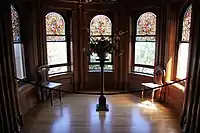 Stained windows in Craigdarroch Castle, a noted feature of the building
Stained windows in Craigdarroch Castle, a noted feature of the building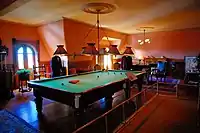 A period exhibit in Craigdarroch's billiards room. The home has served as a historical museum since 1979.
A period exhibit in Craigdarroch's billiards room. The home has served as a historical museum since 1979.
Artwork
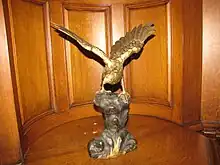
The castle contains many fine examples of paintings, sculpture, and carvings.
References
- Craigdarroch Castle. Canadian Register of Historic Places. Retrieved 30 October 2011.
- "Hatley Castle Website". www.hatleycastle.com. Retrieved 24 September 2013.
- Reksten, Terry (1991). The Dunsmuir Saga . Vancouver: Douglas & McIntyre. p. 200.
- "A Short History of Craigdarroch Castle" (PDF). www.thecastle.ca. Archived from the original (PDF) on 6 February 2013. Retrieved 24 September 2013.
- Segger, Martin and Franklin, Douglas; Victoria: A Primer for Regional History in Architecture; Heritage Architectural Guides, p. 285
- Segger and Franklin, p. 287
- "Craigdarroch Castle". www.stainedglasscanada.ca. Archived from the original on 31 March 2012. Retrieved 24 September 2013.
